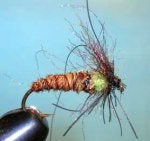I was at the Orvis store the other day and was poking through their flies. They had a cased caddis fly that was simply sand glued to the shank of the hook. It was incredibly realistic. The employee there was on the phone dealing with some personal crisis and the woman there, who works in the clothing section, had no clue.
Any ideas as to how they could have adhered the sand to the hook?
Any ideas as to how they could have adhered the sand to the hook?



